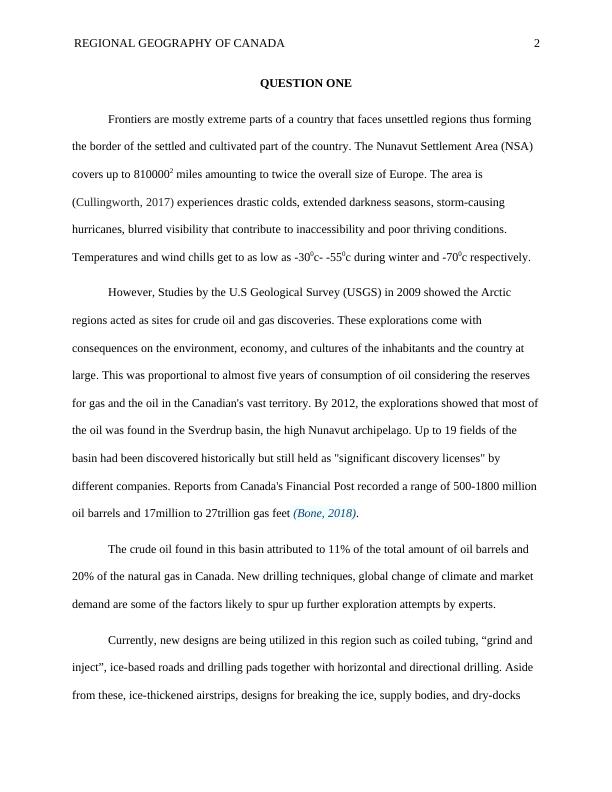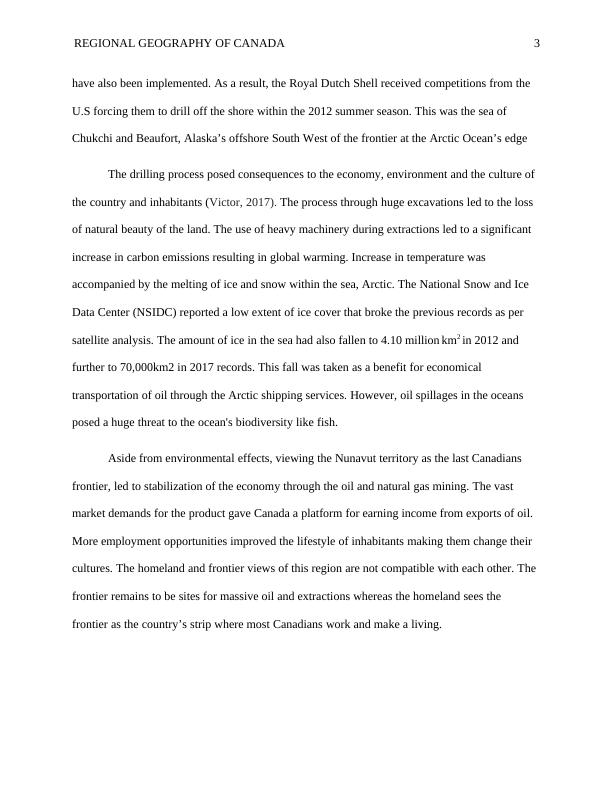Regional Geography of Canada
Added on 2023-01-10
10 Pages2446 Words100 Views
Running Head: REGIONAL GEOGRAPHY OF CANADA 1
Regional Geography of Canada
Student’s Name
Institution affiliation:
Regional Geography of Canada
Student’s Name
Institution affiliation:

REGIONAL GEOGRAPHY OF CANADA 2
QUESTION ONE
Frontiers are mostly extreme parts of a country that faces unsettled regions thus forming
the border of the settled and cultivated part of the country. The Nunavut Settlement Area (NSA)
covers up to 8100002 miles amounting to twice the overall size of Europe. The area is
(Cullingworth, 2017) experiences drastic colds, extended darkness seasons, storm-causing
hurricanes, blurred visibility that contribute to inaccessibility and poor thriving conditions.
Temperatures and wind chills get to as low as -300c- -550c during winter and -700c respectively.
However, Studies by the U.S Geological Survey (USGS) in 2009 showed the Arctic
regions acted as sites for crude oil and gas discoveries. These explorations come with
consequences on the environment, economy, and cultures of the inhabitants and the country at
large. This was proportional to almost five years of consumption of oil considering the reserves
for gas and the oil in the Canadian's vast territory. By 2012, the explorations showed that most of
the oil was found in the Sverdrup basin, the high Nunavut archipelago. Up to 19 fields of the
basin had been discovered historically but still held as "significant discovery licenses" by
different companies. Reports from Canada's Financial Post recorded a range of 500-1800 million
oil barrels and 17million to 27trillion gas feet (Bone, 2018).
The crude oil found in this basin attributed to 11% of the total amount of oil barrels and
20% of the natural gas in Canada. New drilling techniques, global change of climate and market
demand are some of the factors likely to spur up further exploration attempts by experts.
Currently, new designs are being utilized in this region such as coiled tubing, “grind and
inject”, ice-based roads and drilling pads together with horizontal and directional drilling. Aside
from these, ice-thickened airstrips, designs for breaking the ice, supply bodies, and dry-docks
QUESTION ONE
Frontiers are mostly extreme parts of a country that faces unsettled regions thus forming
the border of the settled and cultivated part of the country. The Nunavut Settlement Area (NSA)
covers up to 8100002 miles amounting to twice the overall size of Europe. The area is
(Cullingworth, 2017) experiences drastic colds, extended darkness seasons, storm-causing
hurricanes, blurred visibility that contribute to inaccessibility and poor thriving conditions.
Temperatures and wind chills get to as low as -300c- -550c during winter and -700c respectively.
However, Studies by the U.S Geological Survey (USGS) in 2009 showed the Arctic
regions acted as sites for crude oil and gas discoveries. These explorations come with
consequences on the environment, economy, and cultures of the inhabitants and the country at
large. This was proportional to almost five years of consumption of oil considering the reserves
for gas and the oil in the Canadian's vast territory. By 2012, the explorations showed that most of
the oil was found in the Sverdrup basin, the high Nunavut archipelago. Up to 19 fields of the
basin had been discovered historically but still held as "significant discovery licenses" by
different companies. Reports from Canada's Financial Post recorded a range of 500-1800 million
oil barrels and 17million to 27trillion gas feet (Bone, 2018).
The crude oil found in this basin attributed to 11% of the total amount of oil barrels and
20% of the natural gas in Canada. New drilling techniques, global change of climate and market
demand are some of the factors likely to spur up further exploration attempts by experts.
Currently, new designs are being utilized in this region such as coiled tubing, “grind and
inject”, ice-based roads and drilling pads together with horizontal and directional drilling. Aside
from these, ice-thickened airstrips, designs for breaking the ice, supply bodies, and dry-docks

REGIONAL GEOGRAPHY OF CANADA 3
have also been implemented. As a result, the Royal Dutch Shell received competitions from the
U.S forcing them to drill off the shore within the 2012 summer season. This was the sea of
Chukchi and Beaufort, Alaska’s offshore South West of the frontier at the Arctic Ocean’s edge
The drilling process posed consequences to the economy, environment and the culture of
the country and inhabitants (Victor, 2017). The process through huge excavations led to the loss
of natural beauty of the land. The use of heavy machinery during extractions led to a significant
increase in carbon emissions resulting in global warming. Increase in temperature was
accompanied by the melting of ice and snow within the sea, Arctic. The National Snow and Ice
Data Center (NSIDC) reported a low extent of ice cover that broke the previous records as per
satellite analysis. The amount of ice in the sea had also fallen to 4.10 million km2 in 2012 and
further to 70,000km2 in 2017 records. This fall was taken as a benefit for economical
transportation of oil through the Arctic shipping services. However, oil spillages in the oceans
posed a huge threat to the ocean's biodiversity like fish.
Aside from environmental effects, viewing the Nunavut territory as the last Canadians
frontier, led to stabilization of the economy through the oil and natural gas mining. The vast
market demands for the product gave Canada a platform for earning income from exports of oil.
More employment opportunities improved the lifestyle of inhabitants making them change their
cultures. The homeland and frontier views of this region are not compatible with each other. The
frontier remains to be sites for massive oil and extractions whereas the homeland sees the
frontier as the country’s strip where most Canadians work and make a living.
have also been implemented. As a result, the Royal Dutch Shell received competitions from the
U.S forcing them to drill off the shore within the 2012 summer season. This was the sea of
Chukchi and Beaufort, Alaska’s offshore South West of the frontier at the Arctic Ocean’s edge
The drilling process posed consequences to the economy, environment and the culture of
the country and inhabitants (Victor, 2017). The process through huge excavations led to the loss
of natural beauty of the land. The use of heavy machinery during extractions led to a significant
increase in carbon emissions resulting in global warming. Increase in temperature was
accompanied by the melting of ice and snow within the sea, Arctic. The National Snow and Ice
Data Center (NSIDC) reported a low extent of ice cover that broke the previous records as per
satellite analysis. The amount of ice in the sea had also fallen to 4.10 million km2 in 2012 and
further to 70,000km2 in 2017 records. This fall was taken as a benefit for economical
transportation of oil through the Arctic shipping services. However, oil spillages in the oceans
posed a huge threat to the ocean's biodiversity like fish.
Aside from environmental effects, viewing the Nunavut territory as the last Canadians
frontier, led to stabilization of the economy through the oil and natural gas mining. The vast
market demands for the product gave Canada a platform for earning income from exports of oil.
More employment opportunities improved the lifestyle of inhabitants making them change their
cultures. The homeland and frontier views of this region are not compatible with each other. The
frontier remains to be sites for massive oil and extractions whereas the homeland sees the
frontier as the country’s strip where most Canadians work and make a living.

End of preview
Want to access all the pages? Upload your documents or become a member.
Related Documents
Reports on economic, environmental, and cultural consequences of Nunavutlg...
|10
|2815
|33
Research Methodology | MHH124715lg...
|9
|2594
|20
